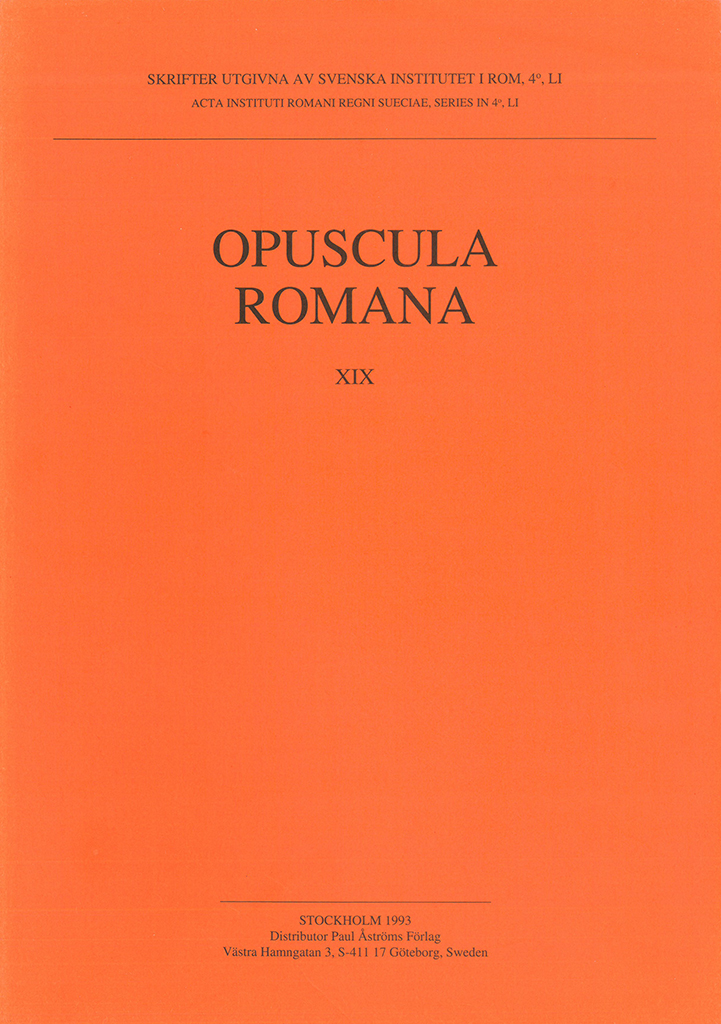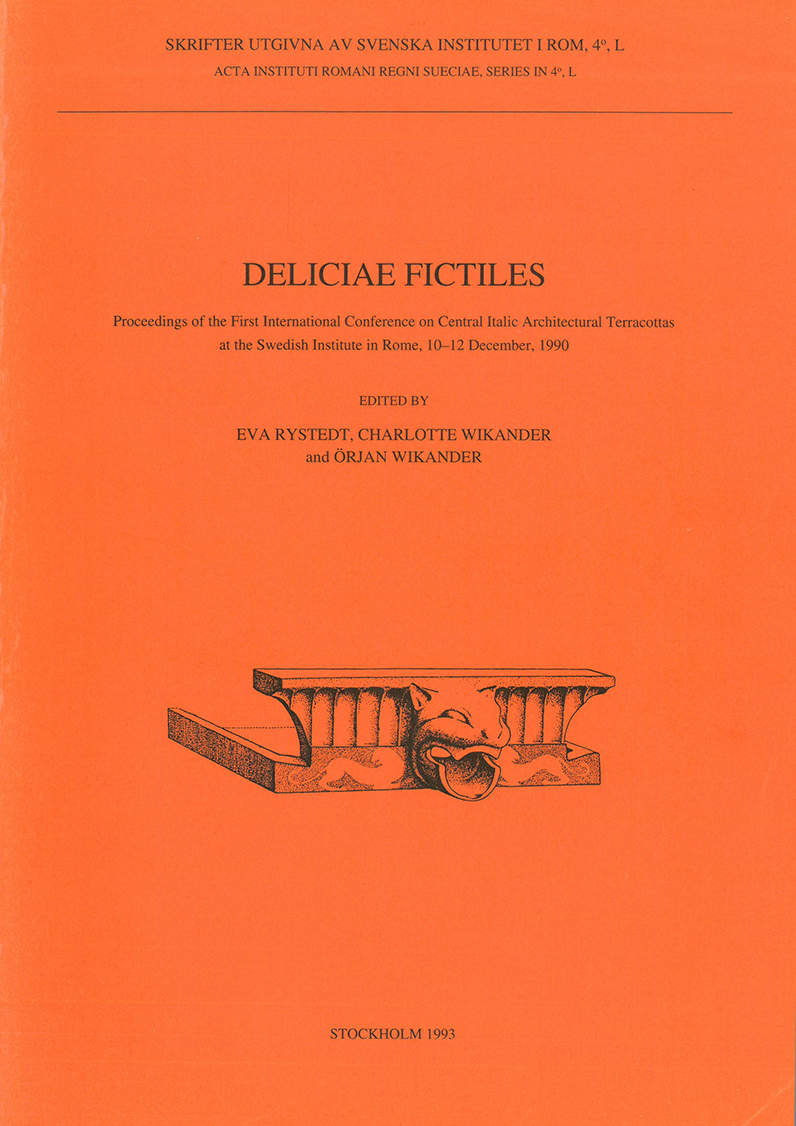Published by the Swedish Institute of Classical Studies in Rome. Distributed by Astrom Editions. Archaeological investigations in southern Etruria Vol. 1. The Civitella Cesi Survey Bibliographical information Pamela Hemphill, Archaeological investigations in southern Etruria vol. 1. The Civitella Cesi Survey (Skrifter utgivna av Svenska institutet i Rom, 4°, 28), Stockholm 2000. Softcover: 160 pp. ISSN 0081-993X. ISBN 9789170421600.
Published by the Swedish Institute of Classical Studies in Rome. Distributed by Astrom Editions. Ancient sculptures in the Royal Museum Vol. 1. The eighteenth-century collection in Stockholm By Anne-Marie Leander Touati, with contributions by Magnus Olausson This is a presentation of the ancient sculptures acquired in the 17th and 18th centuries by Swedish royalty and subsequently arranged into a public museum in 1794. The work is based both on the testimony of written sources and on the examination of the pieces. The documents related to Gustav III’s acquisitions (c. 200 pieces) in Rome between 1784 and 1789 are particularly rich. They yield ample information both on the Roman antiquities market and on the Enlightened, antiquarian tradition in Sweden. The changing attitudes towards the collection from the late 18th century up to the present date are touched upon. The terminology used to describe Roman sculpture is discussed and the 18th-century techniques are surveyed. Finally a catalogue which includes discussion of the 15 main pieces of the collection follows. Contents List of abbreviations Preface Acknowledgements Introduction Part 1. Background 1. The history of collecting 2. The main sources for the collection 3. The collector: Gustav III and his entourage (by Magnus Olausson)…
Published by the Swedish Institute of Classical Studies in Rome. Distributed by Astrom Editions. Fasti Africani. Senatorische und ritterliche Amtsträger in der römischen Provinzen Nordafrikas von Augustus bis Diokletian By Bengt Erik Thomasson Bibliographical information Bengt Erik Thomasson, Fasti Africani. Senatorische und ritterliche Amtsträger in der römischen Provinzen Nordafrikas von Augustus bis Diokletian (Skrifter utgivna av Svenska institutet i Rom, 4°, 53), Stockholm 1997. Softcover: 261 pp. ISSN 0081-993X. ISBN 9789170421532.
Published by the Swedish Institute of Classical Studies in Rome. Distributed by Astrom Editions and Eddy.se AB. Carthage Vol. 1. Carthage I. Results of the Swedish excavations 1979–1983. A Roman bath in Carthage By Cathrine Gerner Hansen. With foreword by Birgitta Sander and Carl-Gustaf Styrenius and contributions by Serge Lancel and Gudrun Anselm Abstract This volume contains the architectural descriptions and analyses of the ruin found by the Swedish Mission to Carthage, SMC, during 1979–1980 within the Unesco programme Pour Sauver Carthage. An archaeological report will follow. The main plot, Site A, which was placed at the disposition of the SMC is located at the foot of the northern incline of Byrsa in the triangle between avenue de la Republique (now avenue de I’ Amphitheatre) and rue Mendes France. Since the excavations were established on the highest point of the saddle between the two Carthaginian heights Byrsa and Juno it was entirely unexpected when the remains of a Roman bath complex were revealed. The finds essentially confirm Saumagne’s theories regarding the layout of Roman Carthage. The main and best preserved remains, labelled Complex II, were part of lnsula 101 E making up the corner between the Cardo I E and…
Published by the Swedish Institute of Classical Studies in Rome. Distributed by Astrom Editions. Pär Göran Gierow dedicata Opuscula Romana 20 Contents Kristina Berggren, Tre tombe a cremazione con trace di legno nella necropolis di Quattro Fontanili a Veio (Roma) Ingrid E.M. Edlund-Berry, The power of cults and sacred spaces. The interpretation romana of sanctuaries in southern Italy and Sicily Maria C. Eriksson, Two Etruscan mirrors in the Thorwaldsen Museum, Copenhagen Björn Forsén & Timo Sironen, Bolli laterizi romani nell’Antikmuseet in Göteborg Lena Landgren, The Roman pleasure garden—foundations for future studies Peter Liljenstolpe, De ornamentis templi Urbis. Reconstructing the main order of the temple of Venus and Roma in Rome Alessandro Naso, Osservazioni sull’origine dei tumuli monumentali nell’Italia centrale David Ridgway, Greek letters at Osteria dell’Osa Paavo Roos, Strabo and the water-mill at Cabeira. Some considerations Raffaele Santillo, Il «saxum ingentem» a Ravenna a copertura del Mausoleo di Teoderico: problemi e soluzioni Martin Söderlind, A central Italic, terracotta votive head in the Classical Museum of Antiquities in Lund (in association with Pierluigi Bianchetti, technical analysis) Margareta Strandberg Olofsson, Pottery from the monumental area at Acquarossa: a preliminary report Bengt E. Thomasson, Laterculi praesidium. Addendorum series altera Örjan Wikander, Senators and equites….
Published by the Swedish Institute of Classical Studies in Rome. Distributed by Astrom Editions. Opuscula Romana 19 Contents Articles Carl Nylander, Gustavo VI Adolfo, il “re archeologo” S.M. Il Re Gustavo VI Adolfo, Discorso in occasione del conferimento della laurea ad honorem Oxford 1955 Olle Brandt, Recent research on the tomb of Eurysaces Peter Danner, Stützen im Giebel—Ein Motiv der etruskischen Wandmalerei Harry Erkell, L’Imperatore Commodo ed Ercole-Melcart Pamela Hemphill, The Romans and the San Giovenale area Bo Lawergren, Lyres in the West (Italy, Greece) and East (Egypt, the Near East), ca. 2000 to 400 B.C. Örjan Wikander, Senators and equites V. Ancestral pride and genealogical studies in Late Republican Rome Charlotte Wikander, Acquarossa: campagna di scavo 1991 The Swedish Institute in Rome. Report for the academic years 1990–91 and 1991–92 Book reviews Charlotte Wikander, review of R.R. Knoop, Antefixa Satricana. Sixth-century architectural terracottas from the sanctuary of Mater Matuta at Satricum (Le Ferriere) Örjan Wikander, review of O. Salomies, Die römischen Vornamen. Studien zur römischen Namengebung Örjan Wikander, review of I. Nielsen, Thermae et balnea. The architecture and cultural history of Roman public baths Örjan Wikander, review of G. Brodribb, Roman brick and tile Göran Bäärnhielm, review of B….
Published by the Swedish Institute of Classical Studies in Rome. Distributed by Astrom Editions. Deliciae fictiles. Proceedings of the First International Conference on Central Italic Architectural Terracottas at the Swedish Institute in Rome, 10–12 December 1990 Edited by Eva Rystedt, Charlotte Wikander & Örjan Wikander Abstract Thirty-three papers on architectural terracottas read at an international conference in Rome. The papers include contributions on Greek material, but the main emphasis is placed on Central Italic roofs (from Northern Etruria to Campania) from the Archaic period. Several papers present hitherto unpublished material, either recently excavated or from earlier, unpublished, excavations and collections. Contents Eva Rystedt, ‘Preface’, p. 7 Arvid Andrén, ‘L’avviamento’, p. 9 ‘General list of abbreviations’, pp. 11–16 Nancy A. Winter, ‘The Greek background for Archaic architectural terracottas of Central Italy’, pp. 17–20 John F. Kenfield, ‘A modelled terracotta frieze from Archaic Morgantina: its East Greek and Central Italian affinities’, pp. 21–28 Concetta Ciurcina, ‘Rapporti tra le terrecotte architettoniche della Sicilia orientale e quelle dell’Italia centrale’, pp. 29–38 Elena Epifanio Vanni, ‘Antefisse di tipo campano a Himera’, pp. 39–43 Maria Bonghi Jovino, ‘La decorazione architettonica di Capua: peculiarità, itinerarii e modelli’, pp. 45–54 Ninina Cuomo di Caprio & Matilde Romito, ‘Fratti…
Published by the Swedish Institute of Classical Studies in Rome. Distributed by Astrom Editions. Fortification towers and masonry techniques in the hegemony of Syracuse, 405–211 B.C. By Lars Karlsson Abstract Syracuse assumed the leadership of the Greek cities after the Carthaginian wars of 409–405 B.C. and the first chapter discusses the four main periods which can be discerned in the archaeological material: (1) the rule of Dionysios I, 405–367 B.C., (2) the period of Timoleon, 244–c. 316 B.C., (3) Agathokles, 316–289 B.C., and (4) the rule of King Hieron II, 270/69–215 B.C. Pyrrhos, as king of Syracuse in 278–276 B.C., was also responsible for work on Sicilian fortifications. Towers with internal crosswalls are treated in Chapter Two and they appear in two types. The first group consists of seven towers with internal walls in the shape of a T (the ‘Epipolai Towers’). The towers are large and square, measuring 10–12 m. (around 30–35 Doric ft.) on a side. The second group of towers with interior walls in the shape of a Greek cross, is common in Sicily. Twelve square examples are known (plus two circular and two semicircular). The square towers frequently measure 6.60 m. (20 Doric ft.) on a…
Published by the Swedish Institute of Classical Studies in Rome. Distributed by Astrom Editions. Arte militare e architettura nuragica. Nuragic architecture in its military, territorial and socio-economic context. Proceedings of the First International Colloquium on Nuragic Architecture at the Swedish Institute in Rome, 7–9 December, 1989 Edited by Barbro Santillo Frizell Abstract Twelve papers given at the first international colloquium on the function of the Sardinian nuraghi held at the Swedish Institute in Rome dealing with, in particular, the military function of the nuraghi in relation to tactics and strategy, their territorial distribution and spatial patterning; models for the interpretations of the social and economic development in nuragic society; the social significance of the nuraghi; and the art of warfare from the evidence of related finds. Contents Barbro Santillo Frizell, ‘Introduzione’, 7–12 Barbro Santillo Frizell, ‘Introduction’, 13–18 Miriam Balmuth, ‘Nuragic camouflage’, 19–22 Paola Basoli & Alba Foschi Nieddu, ‘Il sistema insediativo nuragico nel Monte Acuto: analisi preliminare dei fattori geomorfologici e socio-economici’, 23–40 Lucia Manca Demurtas & Sebastiano Demurtas, ‘Analisi dei protonuraghi nella Sardegna centro-occidentale’, 41–52 Stephen L. Dyson & Robert J. Rowland Jr, ‘Continuity and change in Roman rural Sardinia: The Maryland-Wesleyan survey’, 53–63 Leonore Gallini, ‘Architectural evidence for…
Published by the Swedish Institute of Classical Studies in Rome. Distributed by Astrom Editions. Opuscula Romana 18 Contents Articles Jesper Svenbro, ‘La Cigale et les fourmis. Voix et écriture dans une allégorie grecque’ Kristina Berggren, ‘The Capestrano warrior and the Numana head. A structuralist semiotic interpretation’ Ragnhild Billig, ‘Bilder und Bodenfunde. Kleine Beiträge zur Kenntnis der spätantiken Stadt’ Helle Damgaard Andersen, ‘The feline waterspouts of the lateral sima from the Upper Building at Poggio Civitate, Murlo’ Jane DeRose Evans, ‘Statues of the kings and Brutus on the Capitoline’ Joachim Ganzert, ‘Zweimal zur Vitruv-Interpretation’ Anne-Marie Leander Touati, ‘Commodus wearing the lion skin. A “modern” portrait in Stockholm’ C.S. Lightfoot & Mürsit Yazici, ‘A Roman tomb-group containing two samovars (authepsae) from Kayseri, Turkey’ Kyle M. Phillips, Jr (†), ‘The lateral sima from Poggio Civitate (Murlo): notes on early Etruscan craftsmanship’ Cornelia Weber-Lehmann, ‘Die Dokumentation der etruskischen Grabmalerei aus dem Nachlass Alessandro Moranis’ Charlotte Wikander & Örjan Wikander, ‘The early monumental complex at Acquarossa. A preliminary report’ Örjan Wikander, ‘Senators and equites IV. The case of the Egnatii Field reports Giordano Labud, ‘Rapporto preliminare sulle campagne di scavo del 1988 e del 1989 a San Simone (Simonov Zaliv) presso Isola’ Eva Rystedt, ‘Ricerca…








